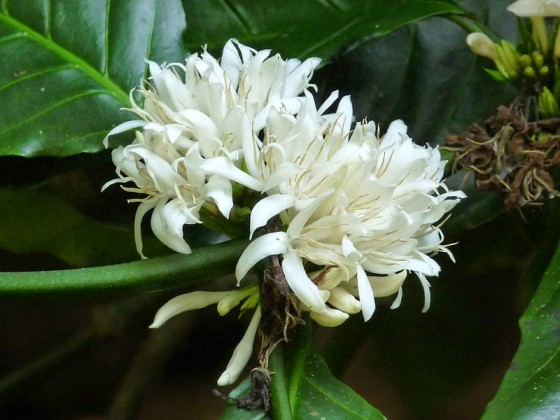You don't know why coffee is synthetic caffeine when you drink coffee every day.
For professional baristas, please follow the coffee workshop (Wechat official account cafe_style)
We drink 2.25 billion cups of coffee every day, which adds up to about 3-4 people who drink one cup a day. With so many people drinking coffee, the area of growing coffee will not be too small. Coffee is grown on an area of 11 million acres worldwide.
Recently, the genome of coffee has been sequenced. Although Arabica coffee (Coffea arabica, 44 chromosomes) is not used for sequencing, but Coffea canephora (C. canephora,22 chromosomes, also known as C. robusta, which accounts for about 30% of the world's total coffee production), Arabica coffee is a hybrid of C. canephora and C. eugenioides.

C. canephora's flowers. Photo Source: wiki
C. the genome of canephora coffee consists of 22 chromosomes with a total size of 710 Mb (Megabase). How big is the 710 Mb? Imagine that the whole genetic body of coffee is printed in front of us, and we read it at the rate of one word per second, which takes 22 years and more than six months to finish. The results of the analysis showed that coffee had a total of 25574 protein-producing genes and 92 microRNA-producing genes. In addition, about half of the entire genome is transposable element.
The special part of the genomes of coffee is that the genes related to disease resistance (R genes) have the phenomenon of tandem repeats (tandem duplication) in the evolution, and the genes that synthesize phenolic secondary compounds (phenylpropanoids) have also increased. These genes include enzymes for the synthesis of flavonoids (isoflavone and flavnoids), alkaloids (alkaloids), monoterpenes (monoterpene), and caffeine (caffeine).
Have you ever wondered why coffee synthesizes caffeine? In fact, coffee synthesizes caffeine mainly to resist insects (in leaves) and to inhibit seed germination of other plants. People living in Ethiopia inadvertently discovered that it had a refreshing effect and began to take its fruit.

C. the fruit of canephora. Fully ripe fruit is bright red. Photo Source: wiki
The production of caffeine is obviously important for the viability of coffee. In the genome, the team saw a cluster of 23 genes, distinct from the other two plants that produce caffeine (tea Camellia sinensis and cocoa cacaoTheobroma cacao).
Although many plants have polyploidy in the process of evolution (such as wheat, corn, cabbage, tomato, etc.), coffee does not appear polyploid, but only selectively repeats in tandem to expand some of the genes to improve their competitiveness.
Whenever I see this evidence, I will think: we use the "toxins" that plants use to ward off insects as Bora to smoke (such as cigarettes) and drink (such as coffee and tea). If the plants know about it, they will certainly laugh. Of course, whether a substance is a drug or a poison is often just a difference in dose. Recently, it is often mentioned in research reports that a cup of coffee a day is more appropriate. For example, in recent years, for the sake of the health of the heart and nerves, coffee has long been limited to one cup a day (the most serious time was four cups a day). Everything is controlled in the "middle way" as far as possible, isn't it?
Important Notice :
前街咖啡 FrontStreet Coffee has moved to new addredd:
FrontStreet Coffee Address: 315,Donghua East Road,GuangZhou
Tel:020 38364473
- Prev

Drinking coffee with five senses is the right way to open boutique coffee!
Professional baristas Please follow the Coffee Workshop (official Wechat account cafe_style) We often think that coffee is tasted by the sense of taste, but in fact, some aromas are put into the mouth and reach the nose, some are the taste sensed by touch. Studies have also confirmed that every senses, including sight, hearing, touch, smell and taste, affect the taste.
- Next

Yield characteristics of Guatemalan Coffee beans
Professional baristas Please pay attention to the Coffee Workshop (Wechat official account cafe_style) the extra hard coffee beans here in Guatemala are full-grained, delicious and balanced, with which the pure full-bodied Guatemalan (Guatemala) coffee once enjoyed a reputation as the best quality coffee in the world, but its quality also declined for a time. What is gratifying, however, is that its reputation is gradually being restored. one
Related
- Beginners will see the "Coffee pull flower" guide!
- What is the difference between ice blog purified milk and ordinary milk coffee?
- Why is the Philippines the largest producer of crops in Liberia?
- For coffee extraction, should the fine powder be retained?
- How does extracted espresso fill pressed powder? How much strength does it take to press the powder?
- How to make jasmine cold extract coffee? Is the jasmine + latte good?
- Will this little toy really make the coffee taste better? How does Lily Drip affect coffee extraction?
- Will the action of slapping the filter cup also affect coffee extraction?
- What's the difference between powder-to-water ratio and powder-to-liquid ratio?
- What is the Ethiopian local species? What does it have to do with Heirloom native species?

